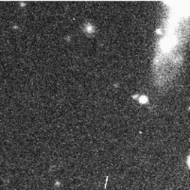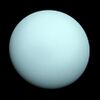Prospero (moon)
Topic: Astronomy
 From HandWiki - Reading time: 3 min
From HandWiki - Reading time: 3 min
 Discovery image of Prospero, taken by the CFHT in July 1999 | |
| Discovery | |
|---|---|
| Discovered by |
|
| Discovery date | 18 July 1999 |
| Designations | |
Designation | Uranus XVIII |
| Pronunciation | /ˈprɒspɛroʊ/[1] |
| Adjectives | Prosperonian /prɒspɛˈroʊniən/,[2] Prosperian /prɒˈspɪəriən/[3] |
| Orbital characteristics | |
| Mean orbit radius | 16,256,000 km[4][5] |
| Eccentricity | 0.4448[5] |
| Orbital period | 1978.29 d |
| Inclination | 152°[4] (to the ecliptic)[4] |
| Satellite of | Uranus |
| Physical characteristics | |
| Mean radius | 25 km (estimate)[6] |
| Surface area | ~8000 km2 (estimate) |
| Volume | ~65,000 km3 (estimate) |
| Mass | ~8.5×1016 kg (estimate) |
| Mean density | ~1.3 g/cm3 (assumed) |
| ~0.0063 m/s2 (estimate) | |
| ~0.021 km/s (estimate) | |
| Rotation period | 7.145 ± 0.092 h |
| Axial tilt | ? |
| Albedo | 0.04 (assumed)[6] |
| Physics | ~65 K (estimate) |
Prospero is a relatively small retrograde irregular satellite of Uranus discovered on 18 July 1999 by the astrophysicist Matthew Holman and his team, and given the provisional designation S/1999 U 3. Confirmed as Uranus XVIII it was named after the sorcerer Prospero in William Shakespeare's play The Tempest.
The orbital parameters suggest that it may belong to the same dynamic cluster as Sycorax and Setebos, suggesting common origin.[7] However, this suggestion does not appear to be supported by the observed colours. The satellite appears neutral (grey) in visible light (colour indices B-V=0.80, R-V=0.39),[8] similar to Setebos but different from Sycorax (which is light red).
See also
- Uranus' natural satellites
- Irregular satellites
References
- ↑ Benjamin Smith (1903), The Century Dictionary and Cyclopedia
- ↑ Emenyonu, Ernest (2003), Emerging perspectives on Chinua Achebe, v. 1.
- ↑ in scare quotes in Bate (1997) The genius of Shakespeare
- ↑ 4.0 4.1 4.2 Sheppard, Jewitt & Kleyna 2005, p. 523, Table 3.
- ↑ 5.0 5.1 Yeomans, Donald K. (28 June 2007). "Planetary Satellite Mean Orbital Parameters". JPL/NASA. http://ssd.jpl.nasa.gov/?sat_elem#uranus. Retrieved 19 January 2008.
- ↑ 6.0 6.1 Sheppard, Jewitt & Kleyna 2005, p. 523, Table 3 ... ri (km) ... 25 ... i Radius of satellite assuming a geometric albedo of 0.04.
- ↑ Grav, Tommy; Holman, Matthew J.; Gladman, Brett J.; Aksnes, Kaare Photometric survey of the irregular satellites, Icarus, 166, (2003), pp. 33–45. arXiv:astro-ph/0301016
- ↑ Grav, Holman & Fraser 2004.
- Grav, Tommy; Holman, Matthew J.; Fraser, Wesley C. (20 September 2004). "Photometry of Irregular Satellites of Uranus and Neptune". The Astrophysical Journal 613 (1): L77–L80. doi:10.1086/424997. Bibcode: 2004ApJ...613L..77G.
- Sheppard, S. S.; Jewitt, D.; Kleyna, J. (2005). "An Ultradeep Survey for Irregular Satellites of Uranus: Limits to Completeness". The Astronomical Journal 129 (1): 518–525. doi:10.1086/426329. Bibcode: 2005AJ....129..518S.
External links
- Prospero Profile by NASA's Solar System Exploration
- David Jewitt pages
- Uranus' Known Satellites (by Scott S. Sheppard)
- MPC: Natural Satellites Ephemeris Service
 |
23 views | Status: cached on July 18 2024 18:06:54
↧ Download this article as ZWI file
 KSF
KSF


